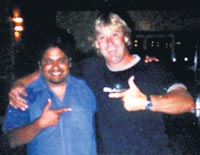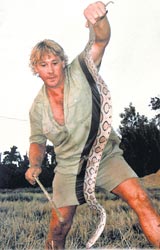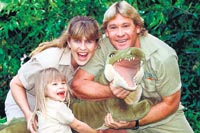|
When the Croc Hunter came to Sri Lanka
By
Ayesha Inoon
Wildlife enthusiast Lalinka recalls
his enduring encounter with Steve Irwin
“I trust animals…..how
could I not trust a man?” Lalinka Muthukumarana
was surprised to hear these words from international
celebrity, Steve Irwin, when Steve called him in response
to an invitation to produce a wildlife programme in
Sri Lanka, in 2003.
Lalinka had never met Steve before
and only knew him like many others did – as the
Aussie star who hosted the famous television show, ‘Crocodile
Hunter’ on Discovery
channel. Even though Lalinka had studied for his
Bachelor’s degree in Perth, Australia from 1996
– 2001, he had never met Steve.
 |
| Lalinka with Steve |
When he returned to Sri Lanka to begin
his own business along with his partner Roshan Ratnayake,
Lalinka decided to turn his personal love of wildlife
into something more. Why not produce a documentary on
Sri Lankan wildlife?
On impulse, Lalinka sent Steve an
e-mail, describing the wealth of wildlife in the island
and asking if he would be interested in doing a special
segment of his programme here. Would he trust him, he
wondered, a stranger from a faraway island. To his amazement,
Steve responded promptly that he would. Excited, Lalinka
and Roshan made arrangements for Steve and his crew
to visit the country.
Now, as the world mourns the sudden
and tragic death of Steve Irwin, Lalinka recalls the
wonderful experience of working with a man who had such
a gift for communicating not only with wild animals,
but also with people from different cultures and backgrounds.
“One of the best things that Steve taught me was
that you don’t need to know the language to converse
with people,” says Lalinka as he speaks of the
natural warmth with which Steve got along with Sri Lankans
at all levels.
 |
| Steve doing what he loved when
he came to Sri Lanka in 2003 |
When it came to animals, Steve’s
knowledge was incredible, says Lalinka. “He would
just look at a monkey on a tree and tell you every single
detail about it. He was also fearless when it came to
dangerous situations involving animals – but it
was a bravery that came of knowing exactly what he was
doing.”
While filming in the Bundala National
Park, a wild elephant had charged them, sending the
trackers and the crew scattering for safety. Steve alone,
had stood his ground and walked towards the charging
elephant. A few feet away from Steve, the elephant had
come to a halt, and then slowly backed off. “It
was a special talent with Steve,” Lalinka recalls.
“Animals seemed to understand him.” In another
instance, he swam behind a man-eating crocodile underwater
to capture its muddy home on film.
Steve was also fascinated by snakes
and believed that all animals should go free in the
wild where they would be safe from harm and not a danger
to humans. They once came across a troupe of gypsies
with their snakes and monkeys in a village. Steve stopped
to ask them if he could buy all their animals and the
gypsies agreed to sell only the snakes -12 of them –
for Rs.80,000. With the 12 snakes in the back of their
jeep Steve and Lalinka drove to a deserted jungle area
in Kandy and set them free. The snakes vanished in an
instant, recollects Lalinka, and Steve remarked, “See
how much they longed to be free.”
 |
| Steve Irwin, pictured here with
his wife Terri and their daughter Bindi Sue during
a photocall at London Zoo to promote Steve and Terri's
movie “The Crocodile Hunter” in this
July 16, 2002 photo. AP |
It wasn’t only animals, says
Lalinka, Steve loved people, especially children, and
he wanted to experience the essence of everything Sri
Lankan. If they passed farmers harvesting in paddy fields,
he would get off the vehicle and join them. He once
joined a group of village children playing cricket,
remarking, “How can an Aussie pass by without
joining a game of cricket?” He even drove a three-wheeler
through the streets of Colombo, remembers Lalinka.
For a man who fearlessly courted danger
– often dealing with animals such as sharks, killer
jellyfish, man-eating crocodiles, snakes and spiders
with fatal stings – death came from a most unexpected
source at the age of 44. While he was diving in the
warm waters of Queensland's Great Barrier Reef to film
a documentary, a stingray shot its poisonous barb into
his heart. He is said to have suffered instant cardiac
arrest.
Stingrays flex their serrated barbs,
which are up to 10 inches long, when frightened. Steve
is believed to be one of three people who have died
in such a manner in Australian waters.
He was planning to visit Sri Lanka
again next year, says Lalinka sadly, still unable to
come to terms with the shocking nature of the death
of a man who had become his friend and mentor over the
years. “He loved Sri Lanka and its people –
he wanted to spread the message that we were so fortunate
to have such beautiful and spectacular wildlife within
easy reach.”
Through his programmes, Steve played
a major role in educating people around the world about
all species of animals and the need for worldwide wildlife
conservation. He even had plans to embark on an Elephant
Conservation Programme in Sri Lanka.
Lalinka says that he hopes to continue
Steve’s good work by bringing his eight-year-old
daughter, Bindi Sue, who is also planning to launch
her own wildlife programme for children, to do a programme
here.
Steve believed that children, especially,
should be taught the value of nature, and that the natural
love that they have for animals should be nurtured into
adulthood. Lalinka hopes his legacy will continue through
his young children, Bindi Sue and Bob.
|
